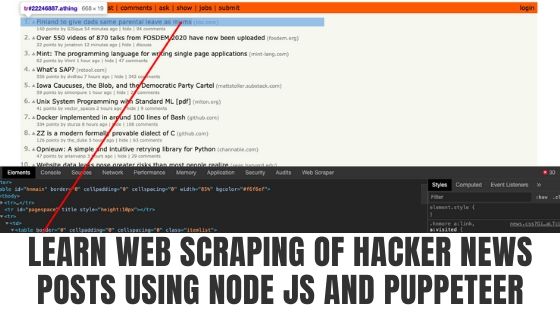In this article, we will learn how to quickly scrape the Hacker News posts using Puppeteer.
Puppeteer uses the Chromium browser behind the scenes to actually render HTML and Javascript and so is very useful if getting the content that is loaded by javascript/AJAX functions.
For this, you will need to install Puppeteer inside a directory where you will write the scripts to scrape the data. For example, make a directory like this...
mkdir puppeteer
cd puppeteer
npm install puppeteer --saveThat will take a moment to install puppeteer and Chromium.
Once done, let's start with a script like this...
const puppeteer = require('puppeteer');
puppeteer.launch({ headless: true, args: ['--user-agent="Mozilla/5.0 (Macintosh; Intel Mac OS X 10_12_6) AppleWebKit/537.36 (KHTML, like Gecko) Chrome/65.0.3312.0 Safari/537.36"'] }).then(async browser => {
const page = await browser.newPage();
await page.goto("https://news.ycombinator.com/");
await page.waitForSelector('body');
var rposts = await page.evaluate(() => {
});
console.log(rposts);
await browser.close();
}).catch(function(error) {
console.error(error);
});Even though it looks like a lot, It just loads up the puppeteer browser, creates a new page and loads the URL we want and waits for the full of the HTML to be loaded.
The evaluate function now gets into the page's content and allows you to query it with puppeteer's query functions and CSS selectors.
The second line where the launch happens instructs puppeteer to load in in the headless mode so you dont see the browser but it's there behind the scenes. The —user-agent string imitates a Chrome browser on a Mac so you dont get blocked.
Save this file as get_HN.js and if you run it, it should not return any errors.
node get_HN.jsNow let's see if we can scrape some data...
Open Chrome and navigate to the Hacker News website.

We are going to scrape the post title, link, upvotes, username and number of comments. Let's open the inspect tool to see what we are up against.
You can see with some tinkering around that each post is encapsulated in a table row tag and the information like points and username and comments details comes in a subsequent tag and another tag used as a separator. So each story takes up 3 rows.

Since everything is inside tags, we are going to use a forEach loop to get the data inside them and get all the individual pieces separately.
So the code will look like this...
const puppeteer = require('puppeteer');
puppeteer.launch({ headless: true, args: ['--user-agent="Mozilla/5.0 (Macintosh; Intel Mac OS X 10_12_6) AppleWebKit/537.36 (KHTML, like Gecko) Chrome/65.0.3312.0 Safari/537.36"'] }).then(async browser => {
const page = await browser.newPage();
await page.goto("https://news.ycombinator.com/");
await page.waitForSelector('body');
var rposts = await page.evaluate(() => {
let posts = document.body.querySelectorAll('tr');
postItems = [];
postItems1 = [];
posts.forEach((item) => {
let title = ''
let summary = ''
let link = ''
try{
title = item.querySelector('.storylink').innerText;
if (title!=''){
link = item.querySelector('.storylink').href;
postItems.push({title: title, link: link});
}
}catch(e){
}
let points='';
let hnuser='';
let comments='';
try{
points = item.querySelector('.score').innerText;
if (points!=''){
hnuser = item.querySelector('.hnuser').innerText;
comments = item.querySelectorAll('.subtext a')[3].innerText;
postItems1.push({points: points, hnuser: hnuser, comments: comments});
}
}catch(e){
}
});
let merged = [];
for(let i=0; iYou can see how the following code gets us the rows.
let posts = document.body.querySelectorAll('tr');
To check if we are getting the row with the post titles, we check for the storylink class as the clue that it is the first of the 3 rows that hold a post's details...
posts.forEach((item) => {
let title = ''
let summary = ''
let link = ''
try{
title = item.querySelector('.storylink').innerText;
if (title!=''){
link = item.querySelector('.storylink').href;
postItems.push({title: title, link: link});
}
}catch(e){
}Similarly, for the other pieces like upvotes and comments, we use the presence of the score class inside the as clue...
let points='';
let hnuser='';
let comments='';
try{
points = item.querySelector('.score').innerText;
if (points!=''){
hnuser = item.querySelector('.hnuser').innerText;
comments = item.querySelectorAll('.subtext a')[3].innerText;
postItems1.push({points: points, hnuser: hnuser, comments: comments});
}
}catch(e){
}Now the problem with this is that we have 2 different arrays with the data... postItems and postItems1 A simple technique to merge the arrays since we know they will always have the exact same number of rows is...
let merged = [];
for(let i=0; iWe passed the merged array back and when we run the whole code, it should print out all the posts and the details we need like so...
If you want to use this in production and want to scale to thousands of links then you will find that you will get IP blocked easily by many websites. In this scenario using a rotating proxy service to rotate IPs is almost a must. Otherwise, you tend to get IP blocked a lot by automatic location, usage and bot detection algorithms.
Our rotating proxy server Proxies API provides a simple API that can solve all IP Blocking problems instantly.
- With millions of high speed rotating proxies located all over the world,
- With our automatic IP rotation
- With our automatic User-Agent-String rotation (which simulates requests from different, valid web browsers and web browser versions)
- With our automatic CAPTCHA solving technology,
Hundreds of our customers have successfully solved the headache of IP blocks with a simple API.
The whole thing can be accessed by a simple API like below in any programming language.
In fact, you dont even have to take the pain of loading Puppeteer as we render Javascript behind the scenes and you can just get the data and parse it any language like Node, Puppeteer or PHP or using any framework like Scrapy or Nutch. In all these cases you can just call the URL with render support like so...
curl "http://api.proxiesapi.com/?key=API_KEY&render=true&url=https://example.com"We have a running offer of 1000 API calls completely free. Register and get your free API Key here.
